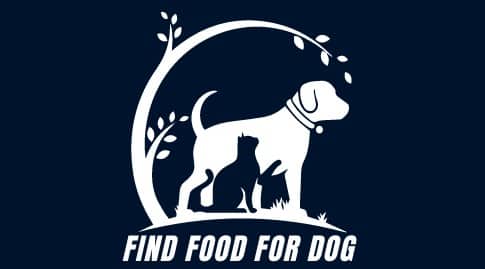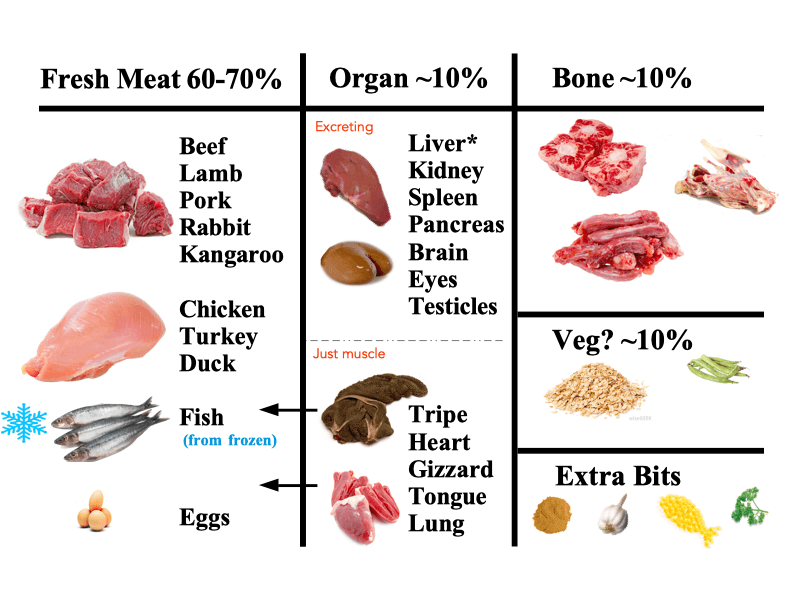A homemade raw food diet for dogs consists of uncooked meats, fruits, and vegetables. This diet aims to mimic a dog's natural eating habits.
Pet owners increasingly seek natural diets for their dogs, promoting health and longevity. A homemade raw food diet can provide essential nutrients tailored to your dog's specific needs. This approach emphasizes fresh, unprocessed ingredients, aiming to enhance overall well-being. Dogs thrive on proteins, healthy fats, and vitamins found in raw foods.
Many owners report improved coat condition and energy levels after transitioning their pets to this diet. However, careful planning is essential to ensure balanced nutrition and avoid deficiencies. Consulting with a veterinarian can help create a safe and effective meal plan for your furry friend.

Customize Homemade Diet Dog Food
Introduction To Raw Feeding
Raw feeding is a growing trend among dog owners. It involves providing a diet similar to what canines ate in the wild. This diet consists mainly of raw meat, bones, and vegetables. Many believe this approach promotes better health and vitality for dogs.
Origins Of Canine Diet
Dogs evolved from wolves. Wild wolves thrived on a diet of:
- Raw meat
- Animal bones
- Fruits and vegetables
Early domesticated dogs ate scraps from human meals. This diet was natural and nutrient-rich. Over time, dogs adapted to various food sources.
Shift To Commercial Foods
The pet food industry exploded in the mid-20th century. Commercial foods became the norm for many dog owners. These foods often contain:
| Ingredient Type | Examples |
|---|---|
| Meat by-products | Ground bones, animal organs |
| Fillers | Corn, soy, wheat |
| Preservatives | BHA, BHT, ethoxyquin |
Many dog owners noticed health issues with commercial foods. Common problems include allergies, obesity, and dental issues. This led to a renewed interest in raw feeding.

Customize Homemade Diet Dog Food
Benefits Of Raw Diets For Dogs
The benefits of a homemade raw food diet for dogs are numerous. Owners often notice significant improvements in their pets' overall health. Understanding these benefits can help you make informed choices for your furry friend.
Enhanced Nutritional Intake
A raw food diet offers dogs a variety of nutrients. These nutrients come from fresh ingredients. Here are some key benefits:
- High-quality proteins: Raw meat provides essential amino acids.
- Vitamins: Fresh fruits and vegetables are rich in vitamins.
- Healthy fats: Raw diets include beneficial omega fatty acids.
Pet owners can mix different protein sources. This ensures a balanced diet. Examples of proteins include:
| Protein Source | Benefits |
|---|---|
| Chicken | Rich in protein and low in fat |
| Beef | High in iron and zinc |
| Fish | Great source of omega-3 fatty acids |
Improved Digestive Function
Raw diets can enhance your dog's digestive health. They often lead to better nutrient absorption. Here’s how:
- Natural enzymes: Raw foods contain natural enzymes that aid digestion.
- Less processed: Less processing means fewer additives and fillers.
- Healthy gut: Raw diets promote a balanced gut microbiome.
Many dogs show fewer digestive issues. This includes less gas and more regular bowel movements. Owners report firmer stools and improved energy levels.
Components Of A Balanced Raw Diet
A balanced raw diet for dogs consists of various essential components. Each part plays a crucial role in your dog's health. Proper nutrition helps maintain energy, coat quality, and overall wellness. Understanding these components ensures your furry friend receives the best care.
Protein Sources
Protein is vital for your dog's growth and energy. Choose high-quality protein sources. Here are some great options:
- Beef
- Chicken
- Turkey
- Lamb
- Fish
Meat should be fresh and free from additives. Organ meats like liver are also nutritious. They provide essential vitamins and minerals. Aim for a variety of protein sources in your dog's diet.
Fruits And Vegetables
Fruits and vegetables add essential nutrients to a raw diet. They provide vitamins, fiber, and antioxidants. Here are some safe options:
| Fruits | Vegetables |
|---|---|
| Apples | Carrots |
| Blueberries | Spinach |
| Bananas | Green beans |
Always wash fruits and vegetables thoroughly. Cut them into small pieces to prevent choking. Avoid toxic foods like grapes and onions.
Supplements And Minerals
Supplements help fill nutritional gaps. Some essential supplements include:
- Fish oil for omega-3 fatty acids
- Probiotics for gut health
- Calcium for bone strength
Consult a vet before adding supplements. Each dog's needs vary. Proper minerals and vitamins support a healthy immune system. Choose high-quality products for the best results.
.webp?width=792&height=1633&name=best-fruits-veggies-raw-food%20(1).webp)
Customize Homemade Diet Dog Food
Safe Food Handling Practices
Keeping your dog's raw food safe is crucial. Proper handling prevents contamination. Follow these practices to ensure your pet's health.
Avoiding Contamination
Contamination can lead to serious health issues. Here are some tips to avoid it:
- Wash hands thoroughly before and after handling food.
- Use separate cutting boards for raw meat and vegetables.
- Keep raw food away from cooked foods.
- Clean surfaces and utensils with hot, soapy water.
Be aware of cross-contamination. Always store raw food in sealed containers. This prevents bacteria from spreading.
Proper Storage And Preparation
Storing raw food correctly is essential. Follow these steps:
| Storage Method | Details |
|---|---|
| Refrigeration | Keep raw food at 40°F or below. |
| Freezing | Store food at 0°F for long-term use. |
Thaw food in the refrigerator, not at room temperature. Prepare meals in clean areas only. Always serve fresh food.
By following these practices, you keep your dog safe and healthy.
Transitioning Your Dog To Raw Food
Switching your dog to a raw food diet can be exciting. It offers health benefits. However, the transition needs care. Rushing may cause digestive issues. A gradual approach works best.
Gradual Introduction
Start with small changes. Mix raw food with their regular kibble. This helps their stomach adjust. Follow these steps:
- Begin with 25% raw food.
- Mix it with 75% kibble.
- Every few days, increase raw food.
- After a week, aim for 50% raw food.
- Continue until you reach 100% raw food.
Be patient during this process. Some dogs take longer to adapt. Monitor their reactions closely.
Monitoring Your Dog's Health
Pay attention to your dog's health during the transition. Look for signs of discomfort. Check for:
- Changes in stool consistency
- Increased energy levels
- Signs of allergies
- Weight changes
Keep a journal of their progress. Note any changes in behavior or health. Consult a vet if you notice any concerns. Regular check-ups ensure your dog is thriving on their new diet.
Customizing The Diet To Your Dog's Needs
Every dog is unique. Their diet should reflect their individual needs. A homemade raw food diet can be tailored for your furry friend. Focus on specific factors to ensure optimal health.
Considering Allergies And Sensitivities
Many dogs have food allergies or sensitivities. Identifying these is crucial for their health. Common allergens include:
- Beef
- Poultry
- Dairy
- Grains
Monitor your dog for any signs of allergies. Symptoms may include:
- Itching
- Ear infections
- Digestive issues
Consult with your vet for an allergy test. This will help you choose safe ingredients.
Adjusting For Age And Activity Level
Your dog's age and activity level impact their dietary needs. Puppies, adults, and seniors require different nutrients.
| Age Group | Dietary Focus |
|---|---|
| Puppies | High protein and fat for growth |
| Adults | Balanced nutrients for maintenance |
| Seniors | Lower calories, higher fiber for digestion |
Take advice from Pet Expert Dr Marty
ESA Pet is an online service that helps you get a legitimate ESA letter
Pet vitamin supplements and grooming products
Activity level also affects calorie needs. Active dogs need more calories than less active ones.
Consider your dog’s specific lifestyle. Adjust the portion sizes and ingredients accordingly.
Potential Risks And How To Mitigate Them
Feeding your dog a homemade raw food diet has risks. Understanding these risks helps keep your dog healthy. Proper planning is key to avoiding issues.
Balancing Nutritional Deficiencies
Raw diets can lack essential nutrients. Dogs need a balanced mix of proteins, fats, vitamins, and minerals. A few key nutrients to focus on include:
- Calcium: Important for strong bones.
- Omega-3 fatty acids: Good for skin and coat.
- Vitamin E: Supports immune health.
Consider these options to balance nutrients:
- Consult a veterinarian for guidance.
- Use quality supplements as needed.
- Rotate protein sources to ensure variety.
Regularly monitor your dog’s health. Adjust the diet based on weight and energy levels.
Preventing Choking And Obstructions
Raw bones can pose choking risks. Choose bones that are appropriate for your dog’s size. Avoid small bones that splinter easily. Consider these safety tips:
- Always supervise your dog while eating.
- Cut larger pieces of food into smaller chunks.
- Remove any dangerous bones or items.
Teach your dog to chew slowly. This prevents choking and improves digestion.
| Risk | Mitigation Strategy |
|---|---|
| Choking | Supervise and cut food into smaller pieces. |
| Obstructions | Avoid small, hard bones and monitor eating. |
Stay aware of your dog’s eating habits. Make adjustments as needed for safety.
Success Stories And Testimonials
Many dog owners have seen amazing results with a Homemade Raw Food Diet. Their pets thrive on natural ingredients. Here are some inspiring stories and expert opinions.
Real-life Transformations
Countless dogs have transformed after switching to a raw food diet. Owners report better energy, shiny coats, and improved digestion.
- Buddy: A 5-year-old Golden Retriever. Lost weight and gained energy.
- Lucy: A 7-year-old Beagle. Allergies reduced significantly.
- Max: A 10-year-old Dachshund. Improved mobility and playfulness.
| Dog Name | Before | After |
|---|---|---|
| Buddy | Overweight, low energy | Healthy weight, active |
| Lucy | Frequent itching | Clear skin, happy |
| Max | Stiff joints | Flexible, playful |
Veterinarian Endorsements
Many veterinarians support the raw food diet for dogs. They emphasize the benefits of natural ingredients. Here are a few notable endorsements:
- Dr. Jane Smith: “Raw diets can improve overall health.”
- Dr. Mike Johnson: “I see fewer health issues in dogs on raw diets.”
- Dr. Emily Brown: “Raw foods help maintain a healthy weight.”
Veterinarians recommend balanced diets. They encourage pet owners to research and consult professionals.
Preparing Your Own Raw Dog Food Recipes
Making your own raw dog food is rewarding. You control ingredients and ensure quality. Homemade meals can boost your dog's health. Here are some simple recipes and innovative ideas.
Simple Starter Recipes
Start with easy recipes to gain confidence. Here are a few simple options:
- Chicken and Veggie Mix
- 1 lb ground chicken
- 1 cup spinach, chopped
- 1/2 cup carrots, grated
- 1/2 cup peas
Mix all ingredients in a bowl. Serve fresh.
- Beef and Sweet Potato Delight
- 1 lb ground beef
- 1 cup sweet potato, cooked and mashed
- 1/2 cup green beans, chopped
Combine ingredients well. Refrigerate unused portions.
- Turkey and Quinoa Bowl
- 1 lb ground turkey
- 1/2 cup cooked quinoa
- 1/2 cup broccoli, chopped
Mix everything together. Serve in a bowl.
Innovative Meal Ideas
Try unique combinations to keep meals exciting. Here are some creative recipes:
- Fish and Fruit Medley
- 1 lb salmon, boneless
- 1/2 apple, chopped
- 1/2 cup blueberries
Blend in a food processor. Serve chilled.
- Lamb and Pumpkin Mash
- 1 lb ground lamb
- 1 cup pumpkin puree
- 1/2 cup spinach, chopped
Mix thoroughly. Freeze leftovers for later use.
- Egg and Veggie Scramble
- 2 eggs, scrambled
- 1/2 cup zucchini, diced
- 1/4 cup bell pepper, diced
Cook in a skillet. Let cool before serving.
Experiment with different ingredients. Always consult your vet before changing your dog's diet. Enjoy creating healthy meals for your furry friend!
Cost Analysis: Homemade Vs. Store-bought
Understanding the costs of a homemade raw food diet for dogs is important. Many pet owners wonder if making food at home is cheaper than buying pre-made options. This section breaks down the expenses clearly.
Breaking Down Expenses
Creating homemade dog food involves several costs. Here’s a breakdown:
| Item | Cost (per month) |
|---|---|
| Meat | $100 |
| Vegetables | $30 |
| Supplements | $20 |
| Miscellaneous | $10 |
| Total | $160 |
Store-bought raw food options also vary in price. Here’s a typical cost:
| Brand | Cost (per month) |
|---|---|
| Ollie Pets Inc | $250 |
| Nom Nom | $300 |
| Pete's Real Food | $280 |
| Average Total | $276 |
Long-term Cost Benefits
Homemade dog food can lead to savings over time. Here are some key points:
- Reduced vet bills: Healthier diets often mean fewer health problems.
- Customizable recipes: Tailor meals to your dog’s needs.
- Ingredient control: Know what goes into your dog’s food.
- Bulk buying: Purchase ingredients in bulk for extra savings.
Consider these long-term benefits:
- Better health leads to lower vet costs.
- Homemade meals can be fresher and more nutritious.
- Dogs may enjoy their food more, improving their appetite.
Evaluate the costs carefully. A homemade raw food diet can be a smart choice.
Frequently Asked Questions About Homemade Raw Food Diet for Dogs
What Is A Raw Food Diet For Dogs?
A raw food diet for dogs consists of uncooked meats, vegetables, and fruits. It aims to mimic the natural diet of wild canines. Proponents believe it improves health, digestion, and coat condition. Always ensure the diet is balanced and consult a vet before making changes.
Is Homemade Raw Food Safe For Dogs?
Homemade raw food can be safe if prepared correctly. Use fresh, high-quality ingredients and follow proper hygiene practices. It's crucial to balance nutrients like protein, fats, and vitamins. Always consult a veterinarian to ensure the diet meets your dog's specific needs and avoids any potential health risks.
How To Prepare Homemade Raw Food For Dogs?
To prepare homemade raw food, start with high-quality meats, organ meats, and bones. Add fresh vegetables and fruits for essential nutrients. Grind or chop ingredients to appropriate sizes. Ensure all components are fresh and clean. Monitor your dog’s health and adjust the recipe as needed.
What Ingredients Should I Avoid In Raw Dog Food?
Avoid ingredients that are toxic to dogs, such as onions, garlic, and grapes. Also, steer clear of processed foods and fillers. Certain bones can splinter and cause injuries, so avoid cooked bones. Always research and consult a veterinarian about safe and healthy ingredients for your dog's diet.
Customize Homemade Diet Dog Food
Conclusion: Homemade Raw Food Diet for Dogs
A homemade raw food diet can greatly enhance your dog's health and vitality. It provides essential nutrients and supports their overall well-being. Always consult a veterinarian before making significant changes to your pet's diet. With proper planning, this diet can lead to happier and healthier dogs.
Embrace the benefits of raw feeding today!














